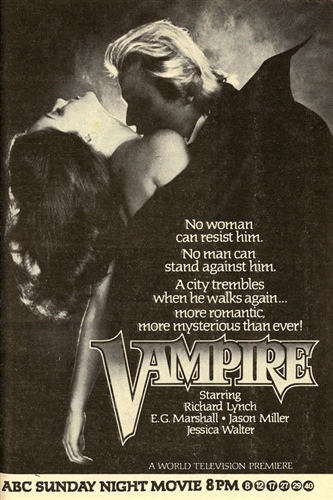 Another of those terrific ABC TV movies—actually the pilot for a never-made series—that went largely unappreciated in its day. For that matter, VAMPIRE is still undervalued, having never been released on home video and, as of 2018, being one of the more difficult to find films of its type.
Another of those terrific ABC TV movies—actually the pilot for a never-made series—that went largely unappreciated in its day. For that matter, VAMPIRE is still undervalued, having never been released on home video and, as of 2018, being one of the more difficult to find films of its type.
It begins with a giant cross being unveiled in a “tragically neglected” part of San Francisco, as part of the dedication of one St. Sebastian church. In the process the shadow of the cross literally burns itself into the ground—and continues to smolder well into the night. From that smoldering ground a growling man emerges.
That man quickly reveals himself as the suave and seductive Anton Voytek, a wealthy—and undead—European immigrant. This guy makes his public debut at a high society party thrown by John, a high powered architect, and his trophy wife Leslie, who were present at the cross unveiling. Anton wants John to help with the unearthing of a long-buried art museum his family supposedly owns.
The project is an ambitious $25 million undertaking that dredges up bones belonging to a long-dead police officer. Shortly after this Anton is arrested because he can’t prove the lineage of the buried museum’s paintings. He’s bailed out of jail the following morning by his wife Nicole, and rushes back to his home, where an open coffin awaits (he, after all, needs his beauty sleep).
That evening Anton pays a visit to Leslie at her house, and seduces her. Her horrifically mutilated corpse is found later that night. The grief-stricken John knows Anton is responsible, and becomes determined to make him pay. He meets up with Harry, as ex-cop who has a history with Anton. Harry reveals that Anton once resided in the submerged museum, but his lair was disturbed by the building of St. Sebastian, and now he’s out for revenge against John and his associates. It’s up to John and Harry to take Anton on—which, of course, is much easier said than done!
VAMPIRE was directed by the veteran TV hack E.W. Swackhamer (1927-1994), who does a workmanlike job that, given the subtle character-driven nature of the material, actually works quite well. The screenplay was co-written by the film’s executive producer, the late TV impresario Steven Bochco (1943-2018), and it contains many quirky and imaginative touches (such a shot of the vampire’s pillow being deflated by a cross), with the violence and bloodletting kept largely off-screen. Unfortunately the script also has a confusingly told narrative that makes frequent jumps forward in time that aren’t identified as such (this is a rare example of a movie that would have benefitted from those usually superfluous subtitles informing us time has passed—i.e. “three weeks later”). The film is also burdened with too many telltale 1970s filmmaking conventions (the too-frequent dissolves in particular) and dialogue like “Oh babe, I love you so much, I love you more than life.”
But this is a film that pivots on its performances, and the acting is uniformly top-notch. The late Jason Miller (1939-2001) delivers a brooding and intense turn as the tormented protagonist, and is given excellent support by sharp players like E.G. Marshall, Jessica Walter and the always-watchable Joe Spinell. Overshadowing them all is the late Richard Lynch (1940-2012) in the title role, an impossibly suave and seductively evil individual, essayed in a supremely extroverted performance that effectively counterpoints the low key nature of the rest of the film. Lynch himself called this his personal favorite movie role, and, quite simply, he was correct in that assessment.
Vital Statistics
VAMPIRE
MTM Enterprises/American Broadcasting Company
Director: E.W. Swackhamer
Producer: Gregory Hoblit
Screenplay: Michael Kozoll, Steven Bochco
Cinematography: Dennis Delzell
Editing: Christopher Nelson
Cast: Jason Miller, Richard Lynch, E.G. Marshall, Kathryn Harrold, Barrie Youngfellow, Michael Tucker, Jonelle Allen, Jessica Walter, David Hooks, Wendy Cutler, Joe Spinell, Stud Klitsner, Scott Paulin, Byron Webster, Brendan Dillon
